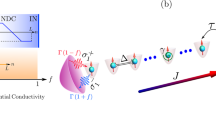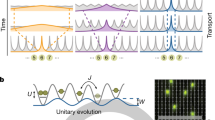Abstract
In 1963 Glauber introduced the modern theory of quantum coherence1, which extended the concept of first-order (one-body) correlations, describing phase coherence of classical waves, to include higher-order (n-body) quantum correlations characterizing the interference of multiple particles. Whereas the quantum coherence of photons is a mature cornerstone of quantum optics, the quantum coherence properties of massive particles remain largely unexplored. To investigate these properties, here we use a uniquely correlated 2 source of atoms that allows us to observe n-body correlations up to the sixth-order at the ideal theoretical limit (n!). Our measurements constitute a direct demonstration of the validity of one of the most widely used theorems in quantum many-body theory—Wick’s theorem3—for a thermal ensemble of massive particles. Measurements involving n-body correlations may play an important role in the understanding of thermalization of isolated quantum systems4 and the thermodynamics of exotic many-body systems, such as Efimov trimers5.
Similar content being viewed by others
Main
Glauber’s modern theory of optical coherence and the famous Hanbury Brown–Twiss effect6 were pivotal in the establishment of the field of quantum optics. Importantly, the definition of a coherent state required coherence to all orders, which for example distinguishes a monochromatic but incoherent thermal source of light from a truly coherent source such as a laser. Higher-order correlation functions therefore provide a more rigorous test of coherence.
Higher-order correlations, characterized by an n-body correlation function g(n), are of general interest and have been investigated in many fields of physics including astronomy6, particle physics7, quantum optics 8, and quantum atom optics9. In particular they have been a fruitful area of research in the field of quantum optics, where they have been used to investigate the properties of laser light, including heralded single photons10, and the statistics of parametric down-conversion sources11. State-of-the-art quantum optics experiments have measured photon correlation functions up to sixth order for quasi-thermal sources8, allowing the possibility of performing full quantum state tomography12.
Higher-order correlations experiments with massive particles are currently approaching the same level of maturity as with photons. So far, experiments have directly observed correlations up to fourth order with single-atom-sensitive detection techniques for ultracold atomic bosons9,13,14, and second-order correlations for an atomic source of fermions15 demonstrating the uniquely quantum mechanical property of atom–atom antibunching. Alternative, indirect techniques have also been employed to investigate higher-order correlations, including the measurements of two-body (photoassociation16) and three-body17 loss rates that are sensitive, respectively, to second- and third-order correlation functions. Interestingly, fermionic atom pairs18 and fermionic antibunching19 have also been observed in the atomic shot noise of absorption images.
In 1963, Glauber predicted that the maximal value of the same-point normalized n-body correlation function g(n) for thermal light is directly related to the order of the function by a simple relationship n! (ref. 1). This n! dependence is a consequence of Wick’s theorem3, which enables higher-order correlations to be expressed using products of one-body correlation functions. The applicability of Wick’s theorem is not limited to just correlation functions for light, it has been also applied in many other fields; for example, it is commonly used in radio-astronomy, nuclear physics7, and generally in quantum field theory3. The validity of Wick’s theorem has been demonstrated with thermal photons, however, so far there have been no direct measurements demonstrating its validity to higher orders for massive particles.
The (unnormalized) two-body spatial correlation function  can be expressed as the probability of detecting two particles simultaneously at two particular locations r1 and r2, where
can be expressed as the probability of detecting two particles simultaneously at two particular locations r1 and r2, where  and
and  are the field creation and annihilation operators. When normalized by the product of atomic densities
are the field creation and annihilation operators. When normalized by the product of atomic densities  at respective locations, the two-body correlation function for a thermal source can be expressed mathematically in terms of the one-body correlation function
at respective locations, the two-body correlation function for a thermal source can be expressed mathematically in terms of the one-body correlation function  :
:

Likewise, the three-body correlation function can be written as a nested series, allowing it to be rewritten in terms of the lower-order correlation functions (Wick’s theorem):

Similarly Wick’s theorem extends to higher orders, but we have omitted them for brevity.
Observing ideal bunching amplitudes requires the correlation length at the detector to be significantly larger than the detector resolution20, which for massive thermal particles has proved challenging, with the maximum bunching amplitudes reported in the literature being at most ∼ 20% [g(2)(0)≈1.2] of the ideal value of g(2)(0) = 1.2 (ref. 21; see Supplementary Methods for the definition of the experimentally measured, volume integrated two-body correlation function at zero interparticle separation). To observe ideal bunching amplitudes, we have employed an ultracold cloud of partially transversely condensed2,22 4He* atoms in a strongly confining optical dipole trap (Fig. 1). This unique cloud can produce ideal bunching amplitudes even with the limited resolution available with current delay-line detectors (∼100 μm spatially, ∼ 1 ns temporally). This is a result of the gas being transversely coherent, but longitudinally incoherent, where interference between the many longitudinal modes occurs over the entire transverse extent of the cloud.
An ultracold cloud of atoms is confined in a tightly focused laser beam. When released, the cloud drops ∼ 85 cm, where its correlation properties are measured using a single-atom detector. Shown in the inset are the mean (dashed blue line) and a typical single (solid red line) longitudinal profile obtained in the experiment.
The experiment is performed using a novel technique (Supplementary Information), where we produce ultracold clouds of 4He* in a highly anisotropic optical dipole trap, aligned with its weak axis in the direction of gravity (z-axis). A simplified schematic of the experiment is shown in Fig. 1. The ultracold atomic cloud is at a temperature of just ∼ 60 nK and contains ∼ 330 atoms. To generate the required statistics, over 2,000 independent realizations of the experiment were undertaken. We measure spatial correlations after time-of-flight expansion, by dropping the clouds onto a single-atom-sensitive delay-line detector located ∼ 85 cm below the trap. An average many-body correlation function can then be calculated.
The major result of this paper is illustrated in Fig. 2, where our near-ideal many-body correlation functions g(n)(Δz)≡g(n)(Δz,…,Δz) (Supplementary Information) up to sixth order are shown as a function of interparticle separation along the longitudinal direction. The peak amplitudes for all the orders are in good agreement with the maximum value of n! expected for the nth order correlation function g(n)(0) for a thermal gas.
The data is averaged over the x and y transverse directions using ∼1 cm×1 cm spatial bins. a–e, A Gaussian fit to the data yields the following peak correlation amplitudes: (a) g(2)(0) = 2.05±0.09, (b) g(3)(0) = 6.0±0.6, (c) g(4)(0) = 23±3, (d) g(5)(0) = 111±16, and (e) g(6)(0) = 710±90. In f we show the n! scaling (dashed line) of the peak correlation amplitudes.
To provide further detail on the three-body correlation function g(3)(Δz) in Fig. 2b, we have also plotted in Fig. 3 a full 2D surface plot of the g(3)(Δz1,Δz2)-function to which g(3)(Δz) = g(3)(Δz,Δz) is the diagonal cut along Δz1 = Δz2. To interpret the surface in Fig. 3, one should realize that the three-body interference term is maximum when all three particles are close together (that is, Δz1 = Δz2∼0). On the other hand, when one of the particles is taken to large separation (that is, Δzi≳2 mm in our case), one recovers the two-body correlation function from this plot, along the remaining dimension. The complete fourth-, fifth-, and sixth-order correlation functions, g(4)(Δz1,Δz2,Δz3), g(5)(Δz1,Δz2,Δz3,Δz4), g(6)(Δz1,Δz2,Δz3,Δz4,,Δz5) require four-, five- and six-dimensional plots respectively, so for clarity we have plotted these in Fig. 2c–e similarly to g(3), that is, for equal spatial separations for all particles.
For atomic systems this is the first reported measurement of the fifth- and sixth-order correlation functions and, importantly, the measurements of the lower-order correlations are up to two orders of magnitude greater in amplitude than previously reported13,14,21. Remarkably, the measurement of the six-body correlation function demonstrates that the probability of finding six particles at the same location is nearly three orders of magnitude greater than for large separations. Surprisingly, to our knowledge our near ideal sixth-order correlation measurement for massive thermal particles surpasses all measurements for thermal photons.
The peak bunching amplitudes (Fig. 2f) of the many-body correlation functions are in agreement with the expected n! dependence of Wick’s theorem for thermal particles, thus confirming the validity of quantum theory of boson statistics for massive particles up to the sixth order1. Counter-intuitively, the signal to noise ratio is approximately unchanged for all orders, owing to the signal from the bunching amplitude rapidly increasing, which compensates for the increased statistical noise due to a reduction in the number of multi-particle interference events for the higher orders. Ultimately, our finite flux limits the order of the correlation function we can accurately produce. Note, that the two-body correlation function, Fig. 2a, directly yields the longitudinal correlation length of the gas. However, for correlation functions greater than two-body, Fig. 2b–e, a compression of the width is observed owing to our effective bin size increasing.
We emphasize that the nature of the critical transition to a transversely condensed gas, which enabled us to measure higher-order correlations at their ideal limit, is a quantum degeneracy driven (rather than interaction driven23) transition of an ideal Bose gas confined to a highly anisotropic trap. As discussed in refs 2, 22, this occurs owing to the saturation of population in the transversely excited states—hence the term ‘transverse condensation’. Our measurements of the transverse properties of the gas, including the fraction of the atoms in the transverse ground state and the transverse correlation functions (to be discussed elsewhere), are indeed in excellent agreement with the predictions of the theory for a harmonically trapped ideal Bose gas. On the other hand, the longitudinal properties of the gas, especially well below the critical temperature, are intermediate between the theory of a highly degenerate ideal Bose gas and a weakly interacting quasicondensate24. Given the relatively small number of atoms in our clouds (a few hundred), we expect the finite-size effects to be significant, which means that the physics in the longitudinal dimension is dominated by broad crossovers between that of a pure non-interacting gas and of a weakly interacting gas approaching the quasicondensate regime. It is perhaps then not surprising that the measured longitudinal correlation length (394 μm) is significantly larger than that predicted by ideal Bose gas theory (95 μm), but shorter than that expected in the quasicondensate regime (∼ 850 μm; Supplementary Information). Nonetheless, we still expect the correlation functions we measure to satisfy the factorial relationship predicted by Wick’s theorem, as the equal-point momentum–momentum correlation function is given by g(2)(k,k)≈2 for both the ideal Bose gas and the weakly interacting quasicondensate regime24.
In conclusion, we have measured near-ideal many-body correlation functions in a thermal ensemble of ultracold 4He* atoms and demonstrated the validity of Wick’s theorem for massive particles to sixth order. Our results show that quantum atom optics experiments can now rival, and in some cases exceed, the performance of quantum optics experiments. The ability to accurately measure photon–photon correlations in quantum optics has been pivotal in enabling some of the foundational tests of quantum mechanics, such as violations of Bell’s inequalities25,26 and the demonstration of Einstein–Podolsky–Rosen entanglement27. Our correlation measurements with ultracold 4He* atoms may pave the way for similar future quantum atom optics tests of the tenets of quantum mechanics for massive particles12. Moreover, higher-order correlations may play an important role as accurate probes of the 3D condensates28, as well as intriguing quantum states incorporating lower dimensions29 and other strongly correlated systems17. Finally, they may also provide unambiguous evidence of p- and d-wave pairings30, which may offer valuable insights into high-temperature superconductivity.
References
Glauber, R. The quantum theory of optical coherence. Phys. Rev 130, 2529–2539 (1963).
Van Druten, N. J. & Ketterle, W. Two-step condensation of the ideal Bose gas in highly anisotropic traps. Phys. Rev. Lett. 79, 549–552 (1997).
Wick, G. C. The evaluation of the collision matrix. Phys. Rev. 80, 268–272 (1950).
Giraud, A. & Serreau, J. Decoherence and thermalization of a pure quantum state in quantum field theory. Phys. Rev. Lett 104, 230405 (2010).
Kramer, T. et al. Evidence for Efimov quantum states in an ultracold gas of caesium atoms. Nature 440, 315–318 (2006).
Hanbury Brown, R. & Twiss, R. Q. A test of a new type of stellar interferometer on Sirius. Nature 178, 1046–1048 (1956).
Baym, G. The physics of Hanbury Brown–Twiss intensity interferometry: From stars to nuclear collisions. Acta Phys. Polonica B 29, 1839–1883 (1997).
Avenhaus, M., Laiho, K., Chekhova, M. & Silberhorn, C. Accessing higher order correlations in quantum optical states by time multiplexing. Phys. Rev. Lett. 104, 063602 (2010).
Yasuda, M. & Shimizu, F. Observation of two-atom correlation of an ultracold neon atomic beam. Phys. Rev. Lett. 77, 3090–3093 (1996).
Uren, A. B., Silberhorn, C., Ball, J. L., Banaszek, K. & Walmsley, I. A. Characterization of the nonclassical nature of conditionally prepared single photons. Phys. Rev. A 72, 021802 (2005).
Ivanova, O. A., Iskhakov, T. Sh., Penin, A. N. & Chekhova, M. V. Multiphoton correlations in parametric down-conversion and their measurement in the pulsed regime. Quant. Electron. 36, 951–956 (2006).
Schilling, U., von Zanthier, J. & Agarwal, G. Measuring arbitrary-order coherences: Tomography of single-mode multiphoton polarization-entangled states. Phys. Rev. A 81, 013826 (2010).
Hodgman, S. S, Dall, R. G., Manning, A. G., Baldwin, K. G. H. & Truscott, A. G. Direct measurement of long-range higher-order coherence in Bose–Einstein condensates. Science 331, 1046–1049 (2011).
Guarrera, V. et al. Observation of local temporal correlations in trapped quantum gases. Phys. Rev. Lett. 107, 160403 (2011).
Jeltes, T. et al. Comparison of the Hanbury Brown–Twiss effect for bosons and fermions. Nature 445, 402–405 (2007).
Kinoshita, T., Wenger, T. & Weiss, D. S. Local pair correlations in one-dimensional Bose gases. Phys. Rev. Lett 95, 190406 (2005).
Haller, E. et al. Three-body correlation functions and recombination rates for bosons in three dimensions and one dimension. Phys. Rev. Lett 107, 230404 (2011).
Greiner, M., Regal, C. A., Stewart, J. T. & Jin, D. S. Probing pair-correlated fermionic atoms through correlations in atom shot noise. Phys. Rev. Lett. 94, 110401 (2005).
Rom, T. et al. Free fermion antibunching in a degenerate atomic Fermi gas released from an optical lattice. Nature 444, 733–736 (2006).
Gomes, J. V. et al. Theory for a Hanbury Brown–Twiss experiment with a ballistically expanding cloud of cold atoms. Phys. Rev. A 74, 053607 (2006).
Dall, R. G. et al. Observation of atomic speckle and Hanbury Brown–Twiss correlations in guided matter waves. Nature Commun. 2, 291 (2011).
Armijo, J., Jacqmin, T., Kheruntsyan, K. V. & Bouchoule, I. Mapping out the quasi-condensate transition through the dimensional crossover from one to three dimensions. Phys. Rev. A 83, 021605 (2011).
Bouchoule, I., Kheruntsyan, K. V. & Shlyapnikov, G. V. Interaction-induced crossover versus finite-size condensation in a weakly interacting trapped 1D Bose gas. Phys. Rev. A 75, 031606 (2007).
Bouchoule, I., Arzamasovs, M., Kheruntsyan, K. V. & Gangardt, D. M. Two-body momentum correlations in a weakly interacting one-dimensional Bose gas. Phys. Rev. A 86, 033626 (2012).
Aspect, A., Dalibard, J. & Roger, G. Experimental test of Bell’s inequalities using time-varying analyzers. Phys. Rev. Lett. 49, 1804–1807 (1982).
Rarity, J. G. & Tapster, P. R. Experimental violation of Bell’s inequality based on phase and momentum. Phys. Rev. Lett 64, 2495–2498 (1990).
Ou, Z., Pereira, F., Kimble, H. & Peng, K Realization of the Einstein–Podolsky–Rosen paradox for continuous variables. Phys. Rev. Lett 68, 3663–3666 (1992).
Perrin, A. et al. Hanbury Brown and Twiss correlations across the Bose–Einstein condensation threshold. Nature Phys. 8, 195–198 (2012).
Manz, S. et al. Two-point density correlations of quasicondensates in free expansion. Phys. Rev. A 81, 031610 (2010).
Kitagawa, T., Aspect, A., Greiner, M. & Demler, E. Phase-sensitive measurements of order parameters for ultracold atoms through two-particle interferometry. Phys. Rev. Lett. 106, 115302 (2011).
Acknowledgements
A.G.T and K.V.K. acknowledge the support of the Australian Research Council through the Future Fellowship grants FT100100468 and FT100100285.
Author information
Authors and Affiliations
Contributions
S.S.H., R.G.D. and A.G.T. conceived the experiment. A.G.M., S.S.H. and W.R. collected the data presented in this Letter. K.V.K. developed the Bose model and provided theoretical insight into the results. All authors contributed to the conceptual formulation of the physics, the interpretation of the data and writing the manuscript.
Corresponding author
Ethics declarations
Competing interests
The authors declare no competing financial interests.
Supplementary information
Supplementary Information
Supplementary Information (PDF 285 kb)
Rights and permissions
About this article
Cite this article
Dall, R., Manning, A., Hodgman, S. et al. Ideal n-body correlations with massive particles. Nature Phys 9, 341–344 (2013). https://doi.org/10.1038/nphys2632
Received:
Accepted:
Published:
Issue Date:
DOI: https://doi.org/10.1038/nphys2632
This article is cited by
-
On the survival of the quantum depletion of a condensate after release from a magnetic trap
Scientific Reports (2022)
-
Observation of the Hanbury Brown–Twiss effect with ultracold molecules
Nature Physics (2022)
-
Experimental characterization of a quantum many-body system via higher-order correlations
Nature (2017)
-
First-order spatial coherence measurements in a thermalized two-dimensional photonic quantum gas
Nature Communications (2017)
-
Ghost imaging with atoms
Nature (2016)






